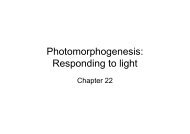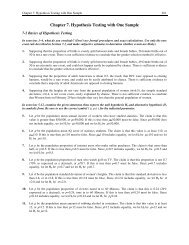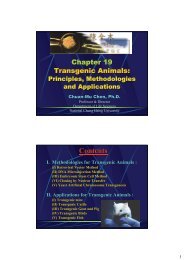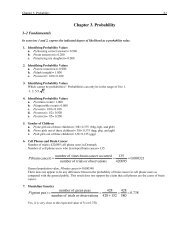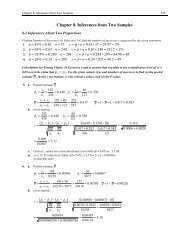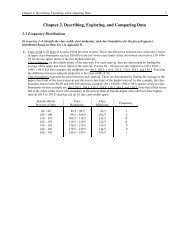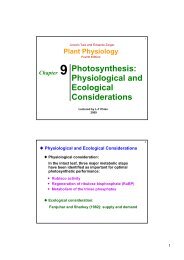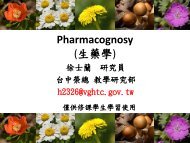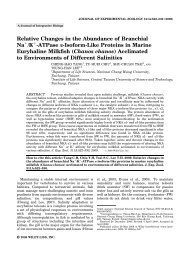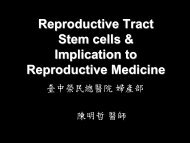GATEWAYï vectors for Agrobacterium-mediated plant transformation
GATEWAYï vectors for Agrobacterium-mediated plant transformation
GATEWAYï vectors for Agrobacterium-mediated plant transformation
You also want an ePaper? Increase the reach of your titles
YUMPU automatically turns print PDFs into web optimized ePapers that Google loves.
Research Update<br />
TRENDS in Plant Science Vol.7 No.5 May 2002<br />
193<br />
What’s next?<br />
Although, the functional question raised<br />
by Levings and Siedow [1] remains<br />
unanswered, knowledge of thioredoxin o<br />
and the associated NTR enriches the<br />
field and opens the door to the<br />
identification of new regulatory events<br />
in <strong>plant</strong> mitochondria.<br />
Acknowledgement<br />
Y.B. gratefully acknowledges the support<br />
of a fellowship from the Swiss National<br />
Science Foundation.<br />
References<br />
1 Levings, C.S. and Siedow, J.N. (1995)<br />
Regulation by redox poise in chloroplast. Science<br />
268, 695–696<br />
2 Laloi, C. et al. (2001) Identification and<br />
characterization of a mitochondrial thioredoxin<br />
system in <strong>plant</strong>. Proc. Natl. Acad. Sci. U. S. A.<br />
98, 14144–14149<br />
3 Buchanan, B.B. (1980) Role of light in the<br />
regulation of chloroplast enzymes. Annu. Rev.<br />
Plant Physiol. 31, 341–374<br />
4 Schürmann, P. and Jacquot, J-P. (2000) Plant<br />
thioredoxin system revisited. Annu. Rev. Plant<br />
Physiol. Plant Mol. Biol. 51, 371–400<br />
5 Buchanan, B.B. et al. The ferredoxin/thioredoxin<br />
system: from discovery to molecular structures<br />
and beyond. Photosynth. Res. (in press)<br />
6 Williams, C.H., Jr et al. (2000) Thioredoxin<br />
reductase: two modes of catalysis have evolved.<br />
Eur. J. Biochem. 267, 6110–6117<br />
7 Arner, E.S.J. and Holmgren, A. (2000)<br />
Physiological functions of thioredoxin and<br />
thioredoxin reductase. Eur. J. Biochem.<br />
267, 6102–6109<br />
8 Fabianeck, R.A. et al. (1998) The active-site<br />
cysteines of the periplasmic thioredoxin-like<br />
protein CcmG of Escherichia coli are important<br />
but not essential <strong>for</strong> cytochrome c maturation<br />
in vivo. J. Bacteriol. 180, 1947–1950<br />
9 Carmel-Harel, O. and Storz, G. (2000) Roles of<br />
the glutathione- and thioredoxin-dependent<br />
reduction systems in the Escherichia coli and<br />
Saccharomyces cerevisiae response to oxidative<br />
stress. Annu. Rev. Microbiol. 54, 439–461<br />
10 Pedrajas, J.R. et al. (1999) Identification and<br />
functional characterization of a novel mitochondrial<br />
thioredoxin system in Saccharomyces cerevisiae.<br />
J. Biol. Chem. 274, 6366–6373<br />
11 Miranda-Vizuete, A. et al. (2000) The<br />
mitochondrial thioredoxin system.<br />
Antioxid. Redox Signal. 2, 801–810<br />
12 Rabilloud, T. et al. (2001) The mitochondrial<br />
antioxidant defense system and its response to<br />
oxidative stress. Proteomics 1, 1105–1110<br />
13 Rouhier, N. et al. (2001) Isolation and<br />
characterization of a new peroxiredoxin from<br />
poplar sieve tubes that uses either glutaredoxin<br />
or thioredoxin as proton donor. Plant Physiol.<br />
127, 1299–1309<br />
14 Cabrillac, D. et al. (2001) The S-locus receptor<br />
kinase is inhibited by thioredoxins and activated<br />
by pollen coat proteins. Nature 410, 220–223<br />
15 Besse, I. and Buchanan, B.B. (1996) Thiocalsin:<br />
a thioredoxin-linked substrate-specific protease<br />
dependent on calcium. Proc. Natl. Acad. Sci.<br />
U. S. A. 93, 3169–3175<br />
16 Mestres-Ortega, D. and Meyer, Y. (1999)<br />
The Arabidopsis thaliana genome encodes at<br />
least four thioredoxins m and a new<br />
prokaryotic-like thioredoxin. Gene 240,<br />
307–331<br />
17 Scheibe, R. (1991) Redox modulation of<br />
chloroplast enzymes. A common principle <strong>for</strong><br />
individual control. Plant Physiol. 96, 1–2<br />
18 Ruelland, E. and Miginiac-Maslow, M. (1999)<br />
Regulation of chloroplast enzyme activities by<br />
thioredoxins: activation or relief of inhibition?<br />
Trends Plant Sci. 4, 136–141<br />
19 Trebitsh, T. and Danon, A. (2001) Translation of<br />
psbA mRNA is regulated by signals initiated by<br />
both photosystems II and I. Proc. Natl. Acad. Sci.<br />
U. S. A. 98, 12289–12294<br />
20 Bodenstein-Lang, J. et al. (1989) Animal and<br />
<strong>plant</strong> mitochondria contain specific thioredoxins.<br />
FEBS Lett. 258, 22–26<br />
21 Marcus, F. et al. (1991) Plant thioredoxin h: an<br />
animal-like thioredoxin occurring in multiple<br />
cell compartments. Arch. Biochem. Biophys. 287,<br />
195–198<br />
22 Hammel, K.E. et al. (1983)<br />
Ferredoxin/flavoprotein-linked pathway <strong>for</strong> the<br />
reduction of thioredoxin. Proc. Natl. Acad. Sci.<br />
U. S. A. 80, 3681–3689<br />
Yves Balmer<br />
Bob B. Buchanan*<br />
Dept of Plant and Microbial Biology,<br />
University of Cali<strong>for</strong>nia, Berkeley, CA 94720,<br />
USA.<br />
*e-mail: view@nature.berkeley.edu<br />
Techniques & Applications<br />
GATEWAY <strong>vectors</strong> <strong>for</strong> <strong>Agrobacterium</strong>-<strong>mediated</strong> <strong>plant</strong><br />
trans<strong>for</strong>mation<br />
Mansour Karimi, Dirk Inzé and Ann Depicker<br />
<strong>Agrobacterium</strong> tumefaciens is the preferred<br />
method <strong>for</strong> trans<strong>for</strong>mation of a wide range<br />
of <strong>plant</strong> species. Commonly, the genes to be<br />
transferred are cloned between the left and<br />
right T-DNA borders of so-called binary<br />
T-DNA <strong>vectors</strong> that can replicate both in<br />
E. coli and <strong>Agrobacterium</strong>. Because these<br />
<strong>vectors</strong> are generally large, cloning can be<br />
time-consuming and laborious. Recently,<br />
the GATEWAY conversion technology<br />
has provided a fast and reliable alternative<br />
to the cloning of sequences into large<br />
acceptor plasmids.<br />
Published online: 11 April 2002<br />
The GATEWAY conversion technology<br />
(Invitrogen, Gaithersburg, MD, USA) is<br />
based on the site-specific recombination<br />
reaction <strong>mediated</strong> by phage λ. DNA<br />
fragments flanked by recombination sites<br />
(att) can be transferred into <strong>vectors</strong> that<br />
contain compatible recombination sites<br />
(attB × attP or attL × attR) in a reaction<br />
<strong>mediated</strong> by the GATEWAY BP<br />
Clonase or LR Clonase Enzyme Mix<br />
(Invitrogen). The entry clones, which can<br />
be considered general donor plasmids, are<br />
made by recombining the DNA fragment<br />
of interest with the flanking attB sites<br />
into the attP site pDONR201 <strong>mediated</strong><br />
by the GATEWAY BP Clonase<br />
Enzyme Mix. Subsequently, the fragment<br />
in the entry clone can be transferred to<br />
any destination vector that contains the<br />
attR sites by mixing both plasmids and by<br />
using the GATEWAY LR Clonase<br />
Enzyme Mix.<br />
Here we describe a set of GATEWAYcompatible<br />
binary T-DNA destination<br />
<strong>vectors</strong> <strong>for</strong> a wide range of different<br />
applications (Fig. 1). Details can be found<br />
on the web site (http://www.<strong>plant</strong>genetics.<br />
rug.ac.be/gateway/), which provides the<br />
complete DNA sequence, a map, and a<br />
Vector NTI view of all constructs. The web<br />
site will be updated regularly by adding<br />
new constructs and relevant in<strong>for</strong>mation.<br />
Backbone of GATEWAY-compatible <strong>vectors</strong><br />
The backbone of all described<br />
GATEWAY-compatible <strong>vectors</strong> is the<br />
plasmid pPZP200 [1]. This plasmid is<br />
relatively small (6.7 kb), contains an<br />
origin <strong>for</strong> replication in E. coli (ColE1) and<br />
in <strong>Agrobacterium</strong> (pVS1), has a pBR322<br />
bom site <strong>for</strong> mobilization from E. coli to<br />
http://<strong>plant</strong>s.trends.com<br />
1360-1385/02/$ – see front matter © 2002 Elsevier Science Ltd. All rights reserved. PII: S1360-1385(02)02251-3
194 Research Update<br />
TRENDS in Plant Science Vol.7 No.5 May 2002<br />
Overexpression or<br />
antisense of a gene<br />
Overexpression of<br />
a gene together with<br />
a visible marker<br />
Double-stranded<br />
RNA (post-transcriptional<br />
gene silencing)<br />
C-terminal gfp fusion<br />
N-terminal gfp fusion<br />
N, C-terminal gfp fusion<br />
Promoter analysis<br />
(gfp–gus fusion)<br />
Trans<strong>for</strong>mation or<br />
complementation with<br />
genomic sequences<br />
T-DNA borders<br />
<strong>plant</strong> selectable markers<br />
nos terminator<br />
<strong>Agrobacterium</strong>, and possesses a<br />
streptomycin and/or spectinomycin<br />
resistance gene <strong>for</strong> plasmid selection.<br />
The T-DNA border regions are derived<br />
from the nopaline plasmid pTiT37 and<br />
contain the 25 bp repeat and outer border<br />
regions but no internal T-DNA sequences;<br />
there<strong>for</strong>e, natural T-DNA sequences are<br />
not transferred into trans<strong>for</strong>med <strong>plant</strong>s.<br />
LB<br />
LB<br />
LB<br />
LB<br />
LB<br />
LB<br />
LB<br />
LB<br />
LB<br />
nos promoter<br />
35S promoter<br />
attR1<br />
Fig. 1. Maps of GATEWAY destination <strong>vectors</strong>.<br />
The vector names were assembled with the following<br />
abbreviations and symbols: *, <strong>plant</strong> selectable marker<br />
(nptII, hpt or bar); 2, promoter of 35S; 7, terminator of<br />
35S; GW, GATEWAY cassette (attR1 with or without<br />
CmR, ccdB, R2 orientation); WG, GATEWAY cassette<br />
(R2, ccdB, with or without CmR, R1 orientation); D, greenfluorescent<br />
protein (GFP) cassette (pRolD–EgfpER–t35S);<br />
F, enhanced GFP (Egfp; Clontech Laboratories, Palo Alto,<br />
CA, USA); S, β-glucuronidase (GUS) sequence.<br />
LB<br />
R1<br />
R2<br />
R2<br />
R2<br />
R1<br />
R2<br />
R1<br />
p*2GW7<br />
R2<br />
p*2WG7<br />
p*7WG2<br />
p*7WG2D<br />
LB R1 R2 R2 R1<br />
RB<br />
p*7WGF2<br />
R2<br />
p*7FWG2<br />
R2<br />
p*7FWGF2<br />
p*GWFS7<br />
p*WG<br />
R2<br />
R1<br />
R1<br />
p*7GWIWG2(II)<br />
attR2<br />
ccdB<br />
CmR<br />
R2<br />
p*7GWIWG2(I)<br />
R1<br />
R1 RB<br />
R2<br />
R1<br />
R1<br />
R1<br />
R2<br />
RB<br />
RB<br />
RB<br />
TRENDS in Plant Science<br />
Destination <strong>vectors</strong><br />
All types of T-DNA destination <strong>vectors</strong> are<br />
available with three <strong>plant</strong> selectable marker<br />
genes: the neomycin phosphotransferase II<br />
(nptII ), the hygromycin phosphotransferase<br />
(hpt), and the bialaphos acetyltransferase<br />
(bar) genes, which confer resistance against<br />
kanamycin, hygromycin and glufosinate<br />
ammonium, respectively. All three selectable<br />
markers are under transcriptional<br />
regulation of the nopaline synthase (nos)<br />
promoter and nos terminator [2] and are<br />
placed at the left side of the T-DNA.<br />
The GATEWAY recombination site<br />
<strong>for</strong> introduction of the fragment of interest<br />
was placed at the right side of the T-DNA.<br />
For construction of all <strong>vectors</strong> in this<br />
collection we used the reading frameA (rfA)<br />
RB<br />
RB<br />
35S terminator<br />
Egfp<br />
rolD promoter<br />
R1<br />
RB<br />
RB<br />
RB<br />
intron<br />
gus<br />
RB<br />
of the GATEWAY vector conversion<br />
system (Invitrogen).<br />
For overexpression of a DNA sequence,<br />
the GATEWAY site was placed between<br />
the promoter and the terminator of the<br />
cauliflower mosaic virus (CaMV) 35S<br />
transcript [3] because that promoter is<br />
highly active in most <strong>plant</strong> cells of<br />
transgenic <strong>plant</strong>s. Downstream of the 35S<br />
promoter part, the tobacco mosaic virus<br />
(TMV) Ω leader ensures efficient translation<br />
of the inserted coding sequences [4]. When<br />
both overexpression and cosuppression of a<br />
cloned sequence are desired, the p*2GW7<br />
and p*2WG7 destination <strong>vectors</strong> should<br />
be used. In these <strong>vectors</strong>, the inserted<br />
sequences are transcribed to the outside of<br />
the T-DNA. Single T-DNA inserts will then<br />
usually result in overexpression of the<br />
transgene whereas specially inverted<br />
T-DNA repeats about the right border will<br />
trigger post-transcriptional silencing of the<br />
transgene and concomitant cosuppression of<br />
homologous endogenes. By contrast, when<br />
only overexpression is desired, p*7WG2 is<br />
the vector of choice. All overexpression<br />
<strong>vectors</strong> can also be used <strong>for</strong> antisense<br />
expression of a particular sequence.<br />
A T-DNA destination overexpression<br />
or antisense vector (p*7WGD2) with an<br />
additional screenable marker was made<br />
essentially <strong>for</strong> the trans<strong>for</strong>mation of<br />
tobacco Bright Yellow 2 (BY2), because<br />
early visualization of transgenic calli is<br />
important. The visible marker cassette<br />
contained the rolD promoter fused to the<br />
coding sequences of the enhanced<br />
green-fluorescent protein (GFP) linked to<br />
the endoplasmic reticulum-targeting<br />
signal (EgfpER) and 35S terminator.<br />
For cosuppression of <strong>plant</strong> endogenes, two<br />
series of destination <strong>vectors</strong> p*7GWIWG2(I)<br />
and p*7GWIWG2(II) were designed in a way<br />
similar to that of the GATEWAY cassette<br />
described by S. Varsha Wesley et al. [5].<br />
The intron cloned between the inverted<br />
GATEWAY fragments was selected from<br />
an Arabidopsis database (ac007123.em_pl)<br />
on the basis of ideal features <strong>for</strong> efficient<br />
splicing (A + T-rich with a branch site close<br />
to the consensus). In the p*7GWIWG2 (II)<br />
series, the chloramphenicol resistance<br />
(CmR) marker was removed from the<br />
GATEWAY cassette and placed inside<br />
the intron. In <strong>plant</strong>s, these T-DNA<br />
destination expression vector constructs<br />
will produce double-stranded RNA<br />
(hairpin RNA) from the inserted sequence<br />
of interest, triggering post-transcriptional<br />
gene silencing in an efficient way.<br />
http://<strong>plant</strong>s.trends.com
Research Update<br />
TRENDS in Plant Science Vol.7 No.5 May 2002<br />
195<br />
The p*GWFS7 <strong>vectors</strong> were<br />
constructed <strong>for</strong> promoter analysis.<br />
In these <strong>vectors</strong>, a frame fusion between<br />
the regions coding <strong>for</strong> EgfpER and<br />
β-glucuronidase (gus) were cloned<br />
downstream of the GATEWAY cassette.<br />
For the localization of particular proteins,<br />
another series of T-DNA destination<br />
<strong>vectors</strong> was designed to allow the N-, C-,<br />
or N- and C-termini of the protein of<br />
interest to be fused to the GFP protein.<br />
Finally, the T-DNA destination vector<br />
p*WG allows the rapid cloning of any gene<br />
or sequence to be trans<strong>for</strong>med into <strong>plant</strong>s.<br />
As a test, the gus-coding sequence was<br />
successfully recombined in all sets of T-DNA<br />
destination <strong>vectors</strong>. Where applicable, the<br />
expected expression was observed in<br />
trans<strong>for</strong>med hairy roots or BY2 cells<br />
(<strong>for</strong> an update see http://www.<strong>plant</strong>genetics.<br />
rug.ac.be/gateway/).<br />
References<br />
1 Hajdukiewicz, P. et al. (1994) The small, versatile<br />
pPZP family of <strong>Agrobacterium</strong> binary <strong>vectors</strong> <strong>for</strong><br />
<strong>plant</strong> trans<strong>for</strong>mation. Plant Mol. Biol. 25, 989–994<br />
2 Hellens, R.P. et al. (2000) pGreen: a versatile and<br />
flexible binary Ti vector <strong>for</strong> <strong>Agrobacterium</strong>-<strong>mediated</strong><br />
<strong>plant</strong> trans<strong>for</strong>mation. Plant Mol. Biol. 42, 819–832<br />
3 Odell, J.T. et al. (1985) Identification of DNA<br />
sequences required <strong>for</strong> activity of the cauliflower<br />
mosaic virus 35S promoter. Nature 313, 810–812<br />
4 Gallie, D.R. et al. (1989) Visualizing mRNA<br />
expression in <strong>plant</strong> protoplasts: factors<br />
influencing efficient mRNA uptake and<br />
translation. Plant Cell 1, 301–311<br />
5 Wesley, S.V. et al. (2001) Construct design <strong>for</strong><br />
efficient, effective and high-throughput gene<br />
silencing in <strong>plant</strong>s. Plant J. 27, 581–590<br />
Mansour Karimi<br />
Dirk Inzé*<br />
Ann Depicker<br />
Dept of Plant Systems Biology, Flanders<br />
Interuniversity Institute <strong>for</strong> Biotechnology (VIB),<br />
Ghent University, K.L. Ledeganckstraat 35,<br />
B-9000 Gent, Belgium.<br />
*e-mail: diinz@gengenp.rug.ac.be<br />
Signal transduction<br />
The special series of Trends in Plant Science articles focussing on<br />
multiple aspects of signal transduction concludes with the May<br />
issue. The complete series is listed below:<br />
• Hirschi, K. (2001) Vacuolar H + /Ca 2+ transport: who’s directing the<br />
traffic? Trends Plant Sci. 6, 100–104<br />
• Pickett, J.A. and Poppy, G.M. (2001) Switching on <strong>plant</strong> genes<br />
by external chemical signals. Trends Plant Sci. 6, 137–139<br />
• Corpas, F.J., Barroso, J.B. and del Río, L.A. (2001) Peroxisomes<br />
as a source of reactive oxygen species and nitric oxide signal<br />
molecules in <strong>plant</strong> cells. Trends Plant Sci. 6, 145–150<br />
• Wendehenne, D., Pugin, A., Klessig, D.F. and Durner, J. (2001)<br />
Nitric oxide: comparative synthesis and signaling in animal<br />
and <strong>plant</strong> cells. Trends Plant Sci. 6, 177–183<br />
• Paul, M., Pellny, T. and Goddijn, O. (2001) Enhancing<br />
photosynthesis with sugar signals. Trends Plant Sci. 6, 197–200<br />
• Memelink, J., Verpoorte, R. and Kijne, J.W. (2001) ORCAnization<br />
of jasmonate-responsive gene expression in alkaloid<br />
metabolism. Trends Plant Sci. 6, 212–219<br />
• Munnik, T. (2001) Phosphatidic acid: an emerging <strong>plant</strong> lipid<br />
second messenger. Trends Plant Sci. 6, 227–233<br />
• Knight, H. and Knight, M.R. (2001) Abiotic stress signalling<br />
pathways: specificity and cross-talk. Trends Plant Sci. 6, 262–267<br />
• Schmülling, T. (2001) CREam of cytokinin signalling: receptor<br />
identified. Trends Plant Sci. 6, 281–284<br />
• Bartels, D. (2001) Targeting detoxification pathways: an efficient<br />
approach to obtain <strong>plant</strong>s with multiple stress tolerance? Trends<br />
Plant Sci. 6, 284–286<br />
• Stals, H. and Inzé, D. (2001) When <strong>plant</strong> cells decide to divide.<br />
Trends Plant Sci. 6, 359–364<br />
• Nürnberger, T. and Scheel, D. (2001) Signal transmission in the<br />
<strong>plant</strong> immune response. Trends Plant Sci. 6, 372–379<br />
• Kim, T-H. , Hoffman, K., von Arnim, A.G. and Chamovitz, D.A.<br />
(2001) PCI complexes: pretty complex interactions in diverse<br />
signaling pathways. Trends Plant Sci. 6, 379–386<br />
• Innes, R.W. (2001) Mapping out roles of MAP kinases in <strong>plant</strong><br />
defense. Trends Plant Sci. 6, 392–394<br />
• Reed, J.W. (2001) Roles and activities of Aux/IAA proteins in<br />
Arabidopsis. Trends Plant Sci. 6, 420–425<br />
• Harrar, Y., Bellini, C. and Faure, J-D. (2001) FKBPs: at the crossroads<br />
of folding and transduction. Trends Plant Sci. 6, 426–431<br />
• Brownlee, C. (2001) The long and the short of stomatal density<br />
signals. Trends Plant Sci. 6, 441–442<br />
• Clouse, S.D. (2001) Integration of light and brassinosteroid<br />
signals in etiolated seedling growth. Trends Plant Sci. 6, 443–445<br />
• Bachmair, A., Novatchkova, M., Potuschak , T. and Eisenhaber, F.<br />
(2001) Ubiquitylation in <strong>plant</strong>s: a post-genomic look at a<br />
post-translational modification. Trends Plant Sci. 6, 463–470<br />
• Rodermel, S. (2001) Pathways of plastid-to-nucleus signaling.<br />
Trends Plant Sci. 6, 471–478<br />
• Lahaye, T. and Bonas, U. (2001) Molecular secrets of bacterial<br />
type III effector proteins. Trends Plant Sci. 6, 479–485<br />
• Hedden, P. (2001) Hormones at Mendel’s birthplace.<br />
Trends Plant Sci. 6, 498–500<br />
• Zhang, S. and Klessig, D.F. (2001) MAPK cascades in <strong>plant</strong><br />
defense signaling. Trends Plant Sci. 6, 520–527<br />
• Muday, G.K. and Delong, A. (2001) Polar auxin transport:<br />
controlling where and how much. Trends Plant Sci. 6, 535–542<br />
• Carré, I.A. (2002) ELF3: a circadian safeguard to buffer effects of<br />
light. Trends Plant Sci. 7, 4–6<br />
• Seo, M. and Koshiba, T. (2002) Complex regulation of ABA<br />
biosynthesis in <strong>plant</strong>s. Trends Plant Sci. 7, 41–48<br />
• Lindsey, K., Casson , S. and Chilley, P. (2002) Peptides: new<br />
signalling molecules in <strong>plant</strong>s. Trends Plant Sci. 7, 78–83<br />
• Lee, J. and Rudd, J.J. (2002) Calcium-dependent protein<br />
kinases: versatile <strong>plant</strong> signalling components necessary <strong>for</strong><br />
pathogen defence. Trends Plant Sci. 7, 97–98<br />
• Drøbak , B.K. and Heras, B. (2002) Nuclear phosphoinositides<br />
could bring FYVE alive. Trends Plant Sci. 7, 132–138<br />
• Fankhauser, C. (2002) Light perception in <strong>plant</strong>s: cytokinins<br />
and red light join <strong>for</strong>ces to keep phytochrome B active.<br />
Trends Plant Sci. 7, 143–145<br />
• Balmer, Y. and Buchanan, B. (2002) Yet another <strong>plant</strong><br />
thioredoxin. Trends Plant Sci. 7, 191–193<br />
• Briggs, W.R. and Christie , J.M. (2002) Phototropins 1 and 2:<br />
versatile <strong>plant</strong> blue-light receptors. Trends Plant Sci. 7, 204–210<br />
• Weber, H. (2002) Fatty acid-derived signals in <strong>plant</strong>s. Trends<br />
Plant Sci. 7, 217–224<br />
• Xing, T., Ouellet, T. and Miki, B.L. (2002) Towards genomics and<br />
proteomics studies of protein phosphorylation in<br />
<strong>plant</strong>–pathogen interactions. Trends Plant Sci. 7, 224–230<br />
http://<strong>plant</strong>s.trends.com




